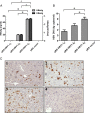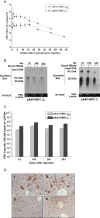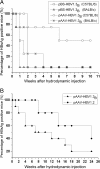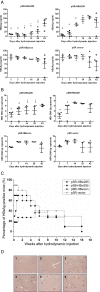Inhibition of hepatitis B virus (HBV) gene expression and replication by HBx gene silencing in a hydrodynamic injection mouse model with a new clone of HBV genotype B
- PMID: 23805945
- PMCID: PMC3751867
- DOI: 10.1186/1743-422X-10-214
Inhibition of hepatitis B virus (HBV) gene expression and replication by HBx gene silencing in a hydrodynamic injection mouse model with a new clone of HBV genotype B
Abstract
Background: It has been suggested that different hepatitis B virus (HBV) genotypes may have distinct virological characteristics that correlate with clinical outcomes during antiviral therapy and the natural course of infection. Hydrodynamic injection (HI) of HBV in the mouse model is a useful tool for study of HBV replication in vivo. However, only HBV genotype A has been used for studies with HI.
Methods: We constructed 3 replication-competent clones containing 1.1, 1.2 and 1.3 fold overlength of a HBV genotype B genome and tested them both in vitro and in vivo. Moreover, A HBV genotype B clone based on the pAAV-MCS vector was constructed with the 1.3 fold HBV genome, resulting in the plasmid pAAV-HBV1.3B and tested by HI in C57BL/6 mice. Application of siRNA against HBx gene was tested in HBV genotype B HI mouse model.
Results: The 1.3 fold HBV clone showed higher replication and gene expression than the 1.1 and 1.2 fold HBV clones. Compared with pAAV-HBV1.2 (genotype A), the mice HI with pAAV-HBV1.3B showed higher HBsAg and HBeAg expression as well as HBV DNA replication level but a higher clearance rate. Application of two plasmids pSB-HBxi285 and pSR-HBxi285 expressing a small/short interfering RNA (siRNA) to the HBx gene in HBV genotype B HI mouse model, leading to an inhibition of HBV gene expression and replication. However, HBV gene expression may resume in some mice despite an initial delay, suggesting that transient suppression of HBV replication by siRNA may be insufficient to prevent viral spread, particularly if the gene silencing is not highly effective.
Conclusions: Taken together, the HI mouse model with a HBV genotype B genome was successfully established and showed different characteristics in vivo compared with the genotype A genome. The effectiveness of gene silencing against HBx gene determines whether HBV replication may be sustainably inhibited by siRNA in vivo.
Figures






Similar articles
-
The dose of HBV genome contained plasmid has a great impact on HBV persistence in hydrodynamic injection mouse model.Virol J. 2017 Oct 25;14(1):205. doi: 10.1186/s12985-017-0874-6. Virol J. 2017. PMID: 29070073 Free PMC article.
-
Susceptibility of different hepatitis B virus isolates to interferon-alpha in a mouse model based on hydrodynamic injection.PLoS One. 2014 Mar 11;9(3):e90977. doi: 10.1371/journal.pone.0090977. eCollection 2014. PLoS One. 2014. PMID: 24618716 Free PMC article.
-
The doses of plasmid backbone plays a major role in determining the HBV clearance in hydrodynamic injection mouse model.Virol J. 2018 May 21;15(1):89. doi: 10.1186/s12985-018-1002-y. Virol J. 2018. PMID: 29783985 Free PMC article.
-
The Epigenetic Modulation of Cancer and Immune Pathways in Hepatitis B Virus-Associated Hepatocellular Carcinoma: The Influence of HBx and miRNA Dysregulation.Front Immunol. 2021 Apr 29;12:661204. doi: 10.3389/fimmu.2021.661204. eCollection 2021. Front Immunol. 2021. PMID: 33995383 Free PMC article. Review.
-
Hepatitis B Virus X and Regulation of Viral Gene Expression.Cold Spring Harb Perspect Med. 2016 Jan 8;6(3):a021402. doi: 10.1101/cshperspect.a021402. Cold Spring Harb Perspect Med. 2016. PMID: 26747833 Free PMC article. Review.
Cited by
-
Coexistence of hepatitis B virus quasispecies enhances viral replication and the ability to induce host antibody and cellular immune responses.J Virol. 2014 Aug;88(15):8656-66. doi: 10.1128/JVI.01123-14. Epub 2014 May 21. J Virol. 2014. PMID: 24850745 Free PMC article.
-
Targeting HBV cccDNA Levels: Key to Achieving Complete Cure of Chronic Hepatitis B.Pathogens. 2024 Dec 13;13(12):1100. doi: 10.3390/pathogens13121100. Pathogens. 2024. PMID: 39770359 Free PMC article. Review.
-
Hydrodynamic Delivery: Characteristics, Applications, and Technological Advances.Pharmaceutics. 2023 Mar 31;15(4):1111. doi: 10.3390/pharmaceutics15041111. Pharmaceutics. 2023. PMID: 37111597 Free PMC article. Review.
-
Target delivery of small interfering RNAs with vitamin E-coupled nanoparticles for treating hepatitis C.Sci Rep. 2016 Apr 26;6:24867. doi: 10.1038/srep24867. Sci Rep. 2016. PMID: 27113197 Free PMC article.
-
Hepatitis B virus genotypes and genome characteristics in China.World J Gastroenterol. 2015 Jun 7;21(21):6684-97. doi: 10.3748/wjg.v21.i21.6684. World J Gastroenterol. 2015. PMID: 26074707 Free PMC article.
References
Publication types
MeSH terms
Substances
LinkOut - more resources
Full Text Sources
Other Literature Sources
Medical

